“This is an all-time record-making month! The very best month for sales that we have ever experienced in our long history.” When you consider that Leopold’s Fine Home Furnishings was established in 1859, surely that calls for a way over-the-moon celebration! Mark Lutz, 5th generation President and his partner and nephew, Chad Leopold, 6th generation, predict blue skies ahead.
But what’s the secret of their dynasty’s success? What inspired Henry Leopold, an 18 year old cabinetmaker and his two older brothers, to leave Essen, Hannover, Germany back in 1853? We do know that it was a time of northern European political crisis when they embarked upon the often hazardous voyage to the Americas, specifically targeting the city of Cleveland, Ohio, population then just over 18,000.
We learn from Henry Leopold’s book, “Glimpses of Greater Cleveland”, published by The Edwin H. Clark Company in 1896, 43 years after Henry’s arrival, that he “commenced his struggle for existence possessing nothing but a debt of $41.00, which money he had borrowed in the old country to pay his way to America. Through perseverance and hard work he saved enough from his small earnings to liquidate this debt, after doing which he considered himself very happy.”
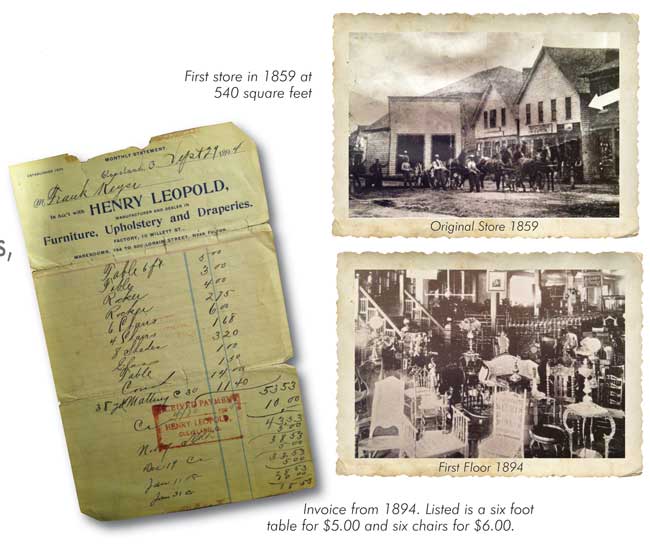
Henry found the foresight and energy to apply himself as a one-man-band to his trade so effectively that, by 1859, he had hired 20 other “newcomers” to assist him in the creation of handcrafted furniture. The workshop was in the basement of Henry’s first official store, the 540 square foot showroom located upstairs on the main floor. The property itself was covered with trees and stumps, “and was purchased at a cost of $8.00 per foot which was, at that time, considered a big price for a lot on the Lorain plank road”. At the intersection of Lorain and busy Fulton Road, on Cleveland’s west side of town, there were typically rough dirt roads, no lighting and a multitude of following horses and buggies. Henry’s first promotional slogan was “From the cheapest that’s good, to the best that’s made.”
In 1857, Henry had married Maria Gertner, born in Bunde, Westfalia. She had also traveled to Cleveland in 1853, part of that same surge of German immigrants.
Henry, with Maria and their growing family of five sons, survived and prospered during the run-up to the Civil War. Mid-century, the city boasted one of the best harbors on Lake Erie, and the bustling activity of the region was fed by a system of numerous waterways including the Ohio Canal which gave access to the interior of the state. The railways, too, with rapidly increasing miles of track, converged on Cleveland. It had become an important key hub for the surrounding cities and states, a crossroads of trade in timber, coal and iron ore. Industry flourished and Cleveland’s population included a growing number of millionaires as the settlement developed from a small town to what was to become an industrial giant.
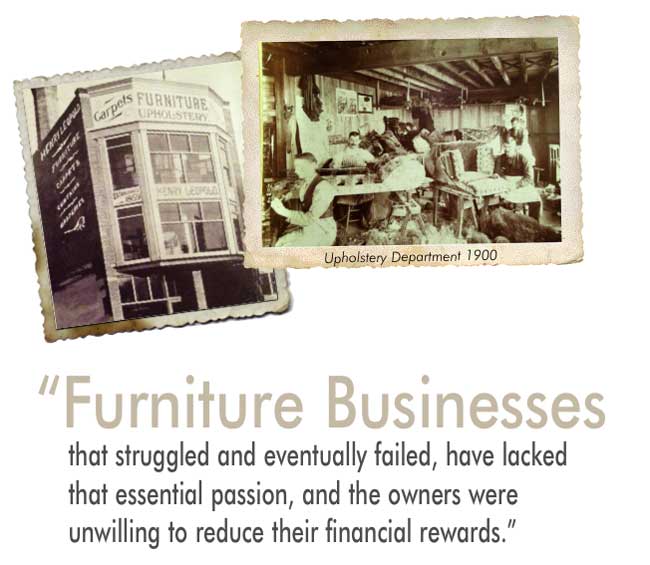
Ship building escalated around Cleveland’s docks, and Henry and his team were already known for the excellence of their craftsmanship. They rapidly became involved in what was to become a long-lasting relationship with lake shipping, constructing the interior wood fittings and finishing and the elaborate, elegant furnishings of the growing fleet of Great Lakes vessels before, during and after the War.
In 1861, a heavily guarded Abraham Lincoln and his entourage travelled by train on the way to his March 4th inauguration in Washington, D.C. They stopped at Cleveland, population now around 43,000, and it’s recorded that 30,000 of those citizens lined the muddy streets along the way to the Weddell House hotel. In the pouring rain, Lincoln spoke from the hotel’s balcony to a huge crowd, amongst the gathering John D. Rockefeller, future founder of Standard Oil and, without doubt, Henry and his wife. Lincoln praised Clevelanders for their “courage, pride in industry and love of country” which certainly the Leopold family took to heart. War was declared a little over a month later. (Lincoln’s train retraced this journey in April 1865, now on the way home to Illinois after his assassination; his coffin was displayed on Public Square.)
When it had become obvious that hostilities were close at hand, the army quickly constructed Cleveland Camp, a 35-acre site right around the corner from Leopold’s store where 15,000 troops were mobilized and trained for battle. Within a few weeks massive casualties sadly created the necessity of adding caskets to Leopold’s line.
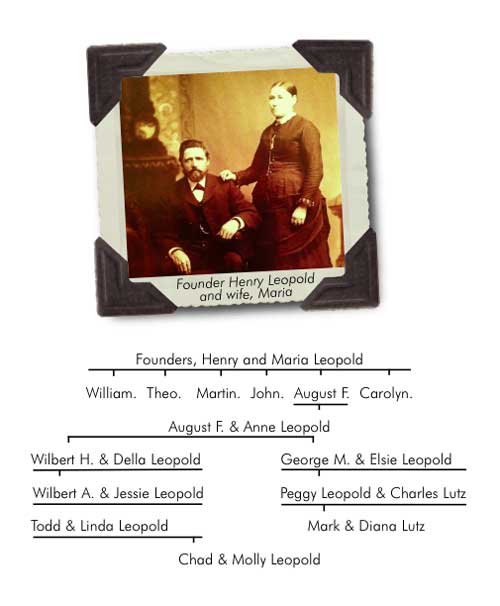
In Mark and Chad’s “treasure sure chest”, an ancient leather suitcase, of sepia-toned photographs, ads, promotional leaflets, clippings and tattered invoices, are multiple references to Cleveland’s shipping saga. “Uncle Wib”, Wilbert A Leopold, third generation, now retired at age 87, but much immersed in family history, said, “We did business with at least three different companies, Cleveland Cliffs, N. A. Hanna Company and Pittsburgh/U.S. Steel. We sold them pilot house chairs for the engine rooms. Leopold’s purchased seats and backs from certain vendors, and bases from separate sources and then custom built the chairs to the companies’ specs using no metal because it would interfere with the compasses.
“Captains received our best quality furniture, some in rosewood, hard rock maple and cherry woods. We furnished their quarters with recliners and bedroom furniture. The quality chosen for the workers was based on their rank... The last trip of the season to dock usually resulted in some of the crew tossing their mattresses overboard to ensure a new set the following season.”
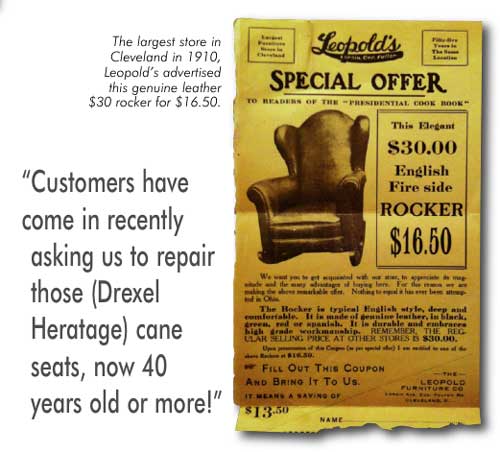
Uncle Wib talked of, “Visiting one of the ships now in a museum in Cleveland, the William B. Mather. Some of the furniture was from Leopold’s.” Mark intends to follow this lead for personal interest and his friendship with the Mather family. “They were very wealthy Clevelanders who lived on Millionaire Row way back when the Rockefellers also had their home in Cleveland.”
Wib recalled that his father, Wilbert H. Leopold, “used to be entertained by shipping executives at Propeller Club parties.”
Photos of some of the ships they served are on exhibition in Leopold’s newly created History Room, along with many other artifacts that date back to their ancestors early days in the area. Said Mark, “The collection has proved to be very interesting to our customers. I believe the Room adds to their confidence and feeling of security in dealing with us. People just can’t believe how long we’ve been in business, it’s intriguing to them. There is no greater statement to our credibility than to see our longevity displayed.”
“Glimpses of Greater Cleveland” describes a disaster that occurred in Leopold’s second decade. “The business prospered and was on the way to success when, in 1871, the building and stock were completely destroyed by fire. Having no insurance, this loss left us almost penniless, but we at once borrowed new capital from friends who asked no security and we began erecting a new building, which showed the wonderful demand for our always reliable goods that we had established. We manufactured all our own furniture. In the year 1886, our warerooms became too small and we at once enlarged the store to meet the demands of our fast increasing trade. Two years later, we again saw the necessity for more room when we put in a modern front, tore down walls and partitions and stocked the entire building with our popular furniture.”
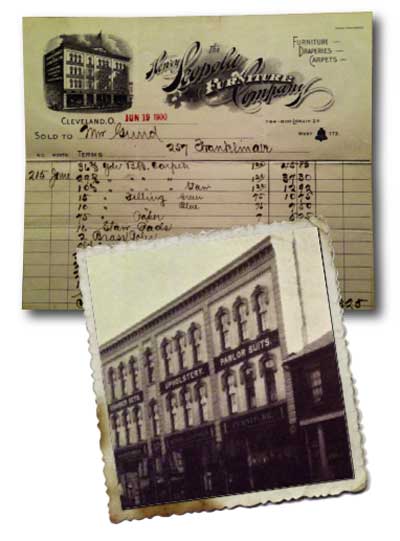
In 1891, Henry became one of the incorporators of The Lorain Street Savings Bank Company and, when the book appeared five years later, he is listed as a Director of the Bank.
“During the succeeding years, the demand for our goods increased to such an extent that we were again required to provide more room and, in May of 1896, we commenced the erection of our new building which is now completed and stocked up with all the newest designs in furniture, carpets and upholstery. (Square footage had climbed over time, from 540 square feet in 1859, to 62,000 square feet by 1896.) We are now ready to supply the public of both sides of the river (perhaps the Cuyahoga?) with anything and everything they may need in our line at as moderate a price as is consistent with first class work.”
The book includes an enlightening addendum: “Mr. Leopold is assisted by his five sons, each of whom has his particular part of the business in charge. Mr. John Leopold is in charge of the shipping department. Mr. August Leopold attends to the buying of all goods. Mr. William Leopold looks after the office and all clerical work pertaining thereto. Mr. Theo Leopold takes charge of the delivering of goods, while Mr. Martin Leopold is at the head of accounts and collection department.”
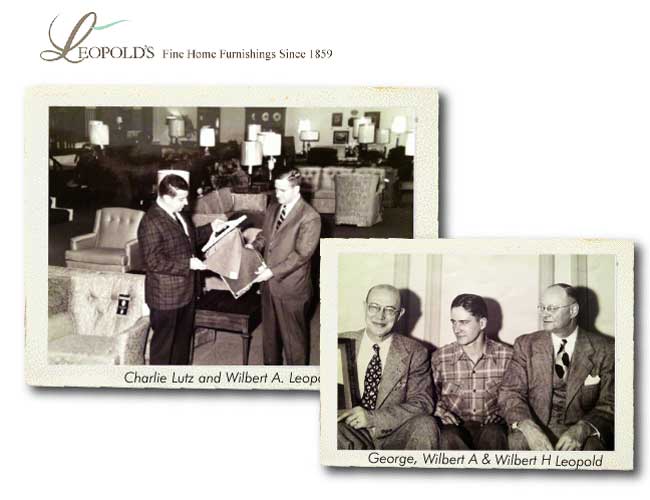
The final commentary was in the form of an invitation: “Mr. Leopold requests the public at any time to call at his store when he will be pleased to show his goods, and a walk through his immense establishment will be appreciated by every lover and admirer of fine furniture.”
Said Mark, “It’s true that furniture created in the mid-l850s and beyond can still be found in Clevelanders’ homes. We have always focused on ‘middle to better goods’ that, hopefully, people will want to keep for the rest of their lives.
“I love our slogan, ‘Beyond the ordinary since 1859!’. It’s a statement of our philosophy. We are occasionally asked to service really old products and one problem we’ve had is finding parts. It seems we have outlived quite a few of our suppliers!
“And there are more recent product lines. In 1973, at the beginning of our association with them, Drexel Heritage had a stand-out collection, an eclectic Art Nouveau marble-topped, round dinette table with cane seat chairs. Customers have come in recently asking us to repair those cane seats, now 40 years old or more! Amusingly, they’ve said to us, ‘We’ve hardly ever used those seats!’ But it’s interesting to see actual imbedded footprints in the cane!” Leopold’s always obliges, however, and the chairs go home with their owners, good as new.
When Henry passed away in 1898, his five sons continued to operate the business until the era of the Great Depression. Mark has records from meetings of the Board of Directors in the 1920s and 1930s. “The Depression had to be an incredible survival effort for us and anybody else that made it.” And it was a critical period for Leopold’s.
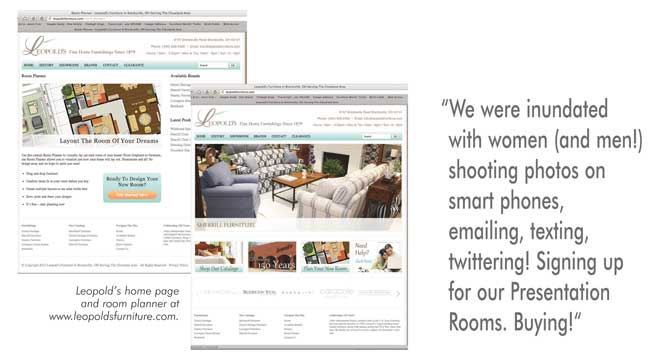
The family owned five stores over the years, one a five-storey corner structure that burned down in 1932, Leopold’s second major fire. It occurred, fortunately, after the business itself had moved to another location. Three of the brothers left the business then, and August carried on with his two sons, Wilbert H. and George M. who had begun working for Leopold’s in their early teens. (George Leopold was Mark’s grandfather, father of only child Peggy, Mark’s mother, who was Henry Leopold’s great grand-daughter.)
“It would appear to have been a necessary reorganization,” said Mark. “Reading the notes on how badly business had tailed off during those times you can see it must have been tough to deal with. I promise you though, in my 38 plus years in business, I’m sure I’ve felt overwhelmed from time to time as they must have. The sacrifices August and his two sons made were well documented. My grandfather and grandmother, George and Elsie, were raising my mother, Peggy. They managed somehow on only $30 a week. His brother was paid the same small amount, and August, their father, only took $5 a week and forgave debt that was owed to him.
“If I were asked today how I would advise a family working to continue their history and business as we have done for 154 years, I believe, that most importantly, I would suggest they make sure that the people making the important business decisions have the greatest passion for the furniture business itself. They must be both willing and qualified to do much or all of the work for little or no monetary rewards when the survival of the business is at stake.
“The businesses that I have observed over the years that struggled and eventually failed, have lacked that essential passion, and the owners were unwilling to reduce their financial rewards. Without passion, perseverance, sacrifice and hard work, the ultimate ending is a Going Out of Business Sale, or bankruptcy.
“We have coped with the most recent recession by cost-cuts and hands-on work. We wear many hats. We saw that some of the businesses around us were beginning to close. One of the reasons we have rebounded so well is that we’ve been able to hire talented people let go from other businesses!
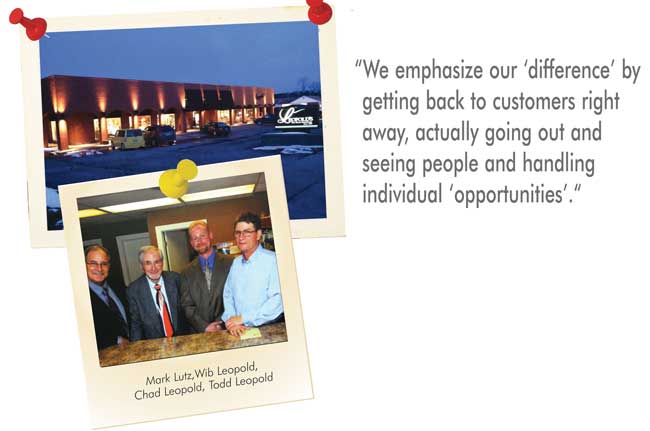
“Both Chad and I focus on opportunity rather than problems, and this relates particularly to customer service. We emphasize our ‘difference’ by getting back to customers right away, actually going out and seeing people and handling individual ‘opportunities’. It means the world to people to receive immediate response, especially today. Our goal is to protect our longevity. It’s great ‘word of mouth’ relationship building!
“August died in 1949, and my father, Charles Lutz, and Wilbert A. became partners. Wilbert semi-retired in the late ‘90s, but my father worked all the way to when he passed away in 2008.”
In 1949, an article in The Cleveland Plain Dealer read, “Leopold’s has exceeded one million dollars gross business several times in recent years.” And, in that same article, “The departmentalization of Leopold’s current building, the former John Marshall High School, was accomplished by utilizing the former classrooms for each line, as upholstery, lighting, dining room furniture, etc. Customers declare that decades after attending John Marshall they feel ‘at home’ shopping where they had once studied mathematics and history!” The Leopold’s had bought the school in 1946. In 1968 they added 5,000 square feet of showroom space at the front of the building, and increased customer parking. They remodeled the interior by tearing out the walls of the old cloakrooms without losing the warm and intimate atmosphere of the school.
“Another special time in the life of Leopold’s occurred in 1973, critical to our moving forward. Drexel Heritage had made the decision to go into stores. My father, Charles, and uncle Wilbert were involved in the negotiations, and Leopold’s became the second store in the U.S. to be engaged in the Drexel Heritage plan. (The first was in Pittsburgh, Pennsylvania.) We found a building in Brecksville, 10 miles directly south of downtown Cleveland, so from 1973 to 1986 we ran two stores. We sold the school in 1986 because we wanted to concentrate on Drexel and the design concept, and the Brecksville store really began to take off.
“At that same time, I graduated with a business degree from Ohio University. Dad had suggested I join the company when I was a sophomore; I’d worked at the stores over the years during holidays. In June, 1974, I both officially joined Leopold’s and married Diana, a banner year!
“We have added many other top lines since then and now have 72 carefully structured room settings, furniture, carpet, area rugs, lighting, mirrors, artwork and accessories. We like to partner with family owned businesses that build their product lines in the U. S. Sherrill Furniture, Vanguard, Bernhardt, are all important to us; they share our passion for the industry. We carry many lines with customizable options, thousands of fabric choices and up to 50 wood finishes. Brecksville is a one-stop-shop, everything you need to beautifully decorate any interior at a fair price, transitional, contemporary or traditional.”
Leopold’s is justly proud of their team of interior designers. Two top talents, with the store for many productive years, Debi Danals and Denise Krejci, are also members of the company’s buying group and travel to High Point with Chad and Mark; they have also attended the Dallas Market solo for accessories. Mark reckons he has attended at least “75 or 80 Markets” and considers them vital to maintaining his and his teams’ knowledge of industry and design trends.
There is a Leopold’s tale that needs to be told! Some years ago, Uncle Wib was honored by the IRS with a dreaded audit. The officials seemed particularly interested in why Wib found it necessary to take his wife, Jessie, with him on business trips to High Point. “Well,” said Wib. “Have you heard of seeing eye dogs? Are blind people allowed to have dogs accompanying them?” The officials agreed that was so. “Then you should understand I have a disability uncommon to home furnishings retailers. I’m color blind! I need my wife with me! I couldn’t be a success in this business if I couldn’t see what I was buying!” The officials dismissed the audit.
The company’s unique design aspect is highly developed, and is handled in a very personal manner with customers. In Leopold’s Presentation Rooms there are “complete computer setups with large TV screens, and pin up boards for fabrics, etc. People sign up for the use of these rooms, and we have half a dozen other work tables in our design area in constant use. Outside designers book with us to come in to utilize our facilities with their clients.”
Designs are conceptualized on computer, then projected to the large screen “to bring the design to life”.
Leopold’s attractive website also offers a terrific, easy to use Room Planner for online customers who then bring their own imaginings to the store for consultation with the designers.
They have no plans to sell on the Internet. “We want to drive customers into the store to see how different we are,” Mark explained. A recent promotion produced just the intended result to the point they were almost overwhelmed with customers. “We were inundated with women (and men!) shooting photos on smart phones, emailing, texting, twittering! Signing up for our Presentation Rooms. Buying!
“Our design team is constantly researching, particularly targeting some of our younger clients, finding the best possible way to keep in touch with them and encourage new people to find us. Social media today is obviously key.
“But tried and true direct mail also works wonders! A local, entrepreneurial printer cold-called us a few months ago. We worked out a promotion with him, a four month shot with an oversized postcard. The results have been fantastic! We are now in the midst of a follow-up which is working equally as well.
“Rarely we use 15 to 30 second TV spots on news programs, early in the morning, at dinnertime or late night before events. But we will buy radio at drive times to coincide with our next direct mail push.
“And there is a beautiful, glossy magazine called ‘Currents’ in the Cleveland trading area. We advertise in it once a month. And this has brought a large response. It’s a very social publication and features local people at events.
“And we never, ever forget the power of word of mouth!
“We try to support as many regional charities as possible, particularly schools and women’s groups, providing them with gift certificates. Community involvement is person-to-person with us.
“Our longevity has given us a unique perspective. We are fortunate in knowing who we are and what we want and need to achieve for our customers and ourselves. We know we are unique. We are surrounded by fleets of mega and chain stores, all advertising, pumping, low prices, no interest, pay next year. We are not bankers, although we do have a credit plan available. We sell better goods, better design, better service to our friends and customers. And you can’t beat our reputation, credibility, integrity and our remarkable longevity!”
Janet Holt-Johnstone is retail editor at Furniture World Magazine.